 zachary harden
zachary harden
Keywords: soldier flags | japan | world war ii | thousand stitch flag |
Links: FOTW homepage | search | disclaimer and copyright | write us | mirrors

FOTW beschäftigt sich mit der Wissenschaft der Vexillologie (Flaggenkunde).
Alle auf dieser Website dargebotenen Abbildungen dienen ausschließlich der Informationsvermittlung im Sinne der Flaggenkunde.
Wir distanziert uns ausdrücklich von allen hierauf dargestellten Symbolen verfassungsfeindlicher Organisationen.
Last modified: 2023-06-03 by  zachary harden
zachary harden
Keywords: soldier flags | japan | world war ii | thousand stitch flag |
Links: FOTW homepage |
search |
disclaimer and copyright |
write us |
mirrors
See also:
The following question was received by FOTW:
My Dad was in Japan in World War 2 and brought back a Japanese flag. I was told that the Japanese soldiers would carry the flag folded inside their shirt and the flags were brightly painted with pictures and family names and/or prayers. I was also told that after the war, the U.S. men on the ships returning home from Japan made duplicates of these flags for souvenirs . I believe that I have one because on the bottom of the material is printed "U.S.N." Could you tell me more about these flags?
I heard that it was popular for Japanese soldiers to bring folded national Hinomaru
with family names and prayers for luck in the war and a thousand-stitch flag which
is long piece of cloth with one thousand red thread stitches sewn by one thousand
women. This was worn by soldiers as a good-luck belt to protect them against bullets
during World War II. In some cases flags with brightly painted strong animal like a tiger
or dragon were used.
Nozomi Kariyasu, 26 February 2002

image contributed by Bill Garrison, 23 January 2008
"[World War II] Japanese Rising Sun naval school flag. [...] The story
I got when I bought it was that this flag came from a naval school
in Japan during [World War II]. Each school had one of these flags named to them.
The flag was a focal point for the students and staff."
Bill Garrison, 23 January 2008 quoting E-Bay seller
The wording says Private School of Kanai Seiran Technology.
I am not sure if the school is a kind of navy school.
The sun seems to be placed in the center like the Imperial Army flag
at that time rather than the Imperial naval ensign.
Nozomi Kariyasu, 23 January 2008

image contributed by Bill Garrison, 25 February 2008

image contributed by Bill Garrison, 25 February 2008
From the E-Bay seller's description:
[Part of] a rare group of items from the Nomonhan Incident (Battle of Khalkin-Gol), 1939; all the former property of a Kwantung Army officer named Sasaki Seitaro. This next item is Sasaki's signed Hinomaru Battle flag made of silk and measuring 27 1/2 X 31 1/2 inches. It is dated Showa 14 (1939), August, Nomonhan, in Japanese. [...] Background: In the months prior to the Nomonhan Incident, the Japanese Kwantung Army Command made a fatal miscalculation. According to Japanese intelligence, Stalin's purges had weakened the USSR's capacity to respond to a military challenge in the region. In April, 1939, the 23rd Division of the Kwantung Army moved against Outer Mongolia. Starting in May, Soviet bombers attacked Manchukuo and Imperial Japanese bombers retaliated. These were among the greatest air battles ever recorded with 150-200 war plane formations. The Soviet response was to dispatch Lieutenant-General Georgi Zhukov to the region in July, 1939. The Red Army's surprise assault began in August, 1939, with a thrust into Western Manchukuo. The superiority of the Soviet mechanized units resulted in repeat reversals for the Japanese. At the Battle of Khalkin-Gol (Nomonhan to the Japanese), Zhukov's forces wiped out the Japanese 23rd Division. When the fighting was over, 18,000 Japanese were dead, and another 20,000 wounded. In the wake of this defeat, which was kept a secret from the Japanese public, Japanese military planners gave up the "Go North" strategy and began to probe areas sensitive to the United States, thus culminating in the attack on Pearl Harbor in December, 1941. A very historic signed Japanese Hinomaru Battle flag.
Bill Garrison, 25 February 2008

image from Jaume Ollé, 27 January, 2013
Source: HistoryImages.blogspot.com
Four flags that I can’t identify:
http://historyimages.blogspot.com.es/2012/10/soviet-army-declares-war-on-japan-in.html
(photo located about the centre of the page)
Jaume Ollé, 27 January 2013
Not to load an enormous page full of images.
Image (also somewhat larger)
Caption: "Russian sailors with captured Japanese flags"
No other information regarding the photograph, except that the page context is
operation August Storm, the Soviet operation against Japan's mainland conquests,
directly following the destruction of Hiroshima, Augustus 1945.
Peter Hans van den Muijzenberg, 28 January 2013
Well, let's see what we can add:
- The flag to the viewers right is the only one that is actually intended to be vertical, but the tag hanging in front of it makes it impossible to read the character. At first sight it would appear to have two zigzag lines, as more Japanese flags have (Does anyone know more about what those stand for?), but a closer look reveals an extra line
above, and the two dark lines might not be the exact same colour. The flag held by the second flag from the viewer's left follow this patterns with its lines as well. Though the colours can't be determined exactly, they would seem to follow the pattern on the
flag of Manchukuo. Indeed, this matches the location of Japanese mainland conquests. The "tag" hanging in front of it would probably tell us all we wanted to know, but unfortunately it can't be read in the photograph.
- The Second flag from the viewers left has the same colours running as four lines across the flag. In this case the colour of the field really seems a bit darker than what would be the white stripe, so I expect this to be mustard yellow. The order of the lines tells us the Russian sailor is probably holding the flag the wrong way round. The flag is longer even then it would seem; his gun prevents him from holding it up properly. In reality the badge is likely to be in the centre of an 1:2 flag. The structure of the ring gives the impression of a very short circular rail road. That's not the common style for rail road emblems, though, and the flag isn't mentioned on
Japanese controlled transport companies (China). It may well have a different meaning entirely, though I can't shake the feeling I've seen it somewhere before. Though the reverse of the flag, the character seems to be correct; at the moment I can't come up with its meaning, though. Anyone?
- First to the viewer's left. Definitely saw a wreath like that before, but where?
- Second from the viewer's right; I'm tempted to say this one is held the wrong way as well, as the character would seem to read best from the viewer's right. It's still unreadable because of the folds, though. Comparing with the other flags, I'd go for blue thick border, than white then black inner border, with a mustard yellow field and red character. The blue and red aren't all that certain, though.
Peter Hans van den Muijzenberg, 3 February 2013
About 10 years ago I read various books about the war
experiences of American soldiers involved in fighting against the
Japanese in the Pacific Theater. I recall reading that one method for
unemployed women of Japanese origin (on Guam, Saipan and Okinawa) to
earn some income was to take locally produced Japanese flags, get in a
"sewing circle" and write Japanese-character names on them, and then
passing them on to another Japanese gal to get different
Japanese-character "handwritings" on them. These flags would then be
sold as "war trophies" to unsuspecting, late-arriving, second-echelon
American soldiers who were occupying the islands. Many of which may be
appearing on eBay nowdays.
Bill Garrison, 26 February 2008
Hosted by: Fanshop-Online.de und Handy-Shop.de
Tipp: Apple iPhone 15 im Shop